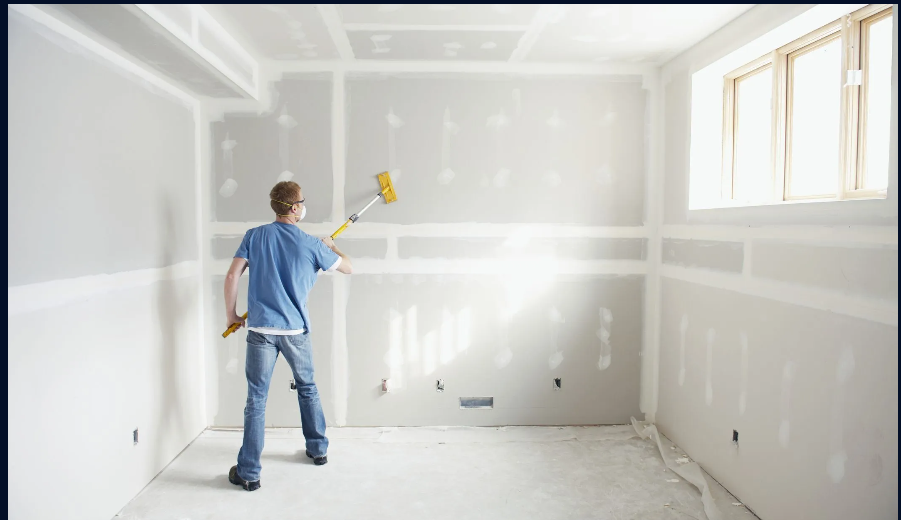Drywall repair is a common household task that can seem intimidating to those who have never attempted it before. However, with the right tools and a bit of patience, anyone can learn how to fix minor holes, cracks, or dents in their drywall. In this guide, you will find a step-by-step process to help you tackle drywall repairs with ease. Whether you’re dealing with small nail holes or larger damage, this simple approach will guide you through the entire process.
When it comes to drywall repairs, understanding the right materials and techniques is key to achieving a professional result.
Tools You’ll Need for Drywall Repair
Before starting any drywall repair project, it’s essential to gather all the necessary tools. These are some of the basic items you will need to make your job easier and more efficient:
- Utility knife: Used for cutting the drywall to shape.
- Spackle or joint compound: To fill in holes and cracks.
- Putty knife or drywall knife: For applying and smoothing out the compound.
- Drywall patch (if needed): For larger holes that need more than just spackle.
- Sanding block or sponge: For smoothing the surface once the compound has dried.
- Primer and paint: To finish the repair and blend it into the rest of the wall.
Having these tools ready will ensure that you can complete your drywall repair with minimal hassle.
Step 1: Assess the Damage
The first step to repairing drywall is to assess the damage. Drywall damage can come in various forms, including holes, cracks, dents, or even water damage. Each type of damage will require a slightly different approach. Here are a few common types of drywall damage and how to repair them:
Small Holes (Nail or Screw Holes)
These are the most common types of damage. They are often caused by nails, screws, or small dings in the drywall. Repairing these is a relatively easy task.
Larger Holes (Larger than 1 inch)
Larger holes, often caused by accidents or impact, require a more involved repair process. You’ll need to use a drywall patch to cover these areas.
Cracks
Cracks are usually caused by the settling of the home or structural movement. These can be repaired with joint compound and a bit of effort to smooth them out.
Step 2: Prepare the Area
Once you’ve identified the damage, the next step is to prepare the area. For a clean and smooth repair, follow these steps:
- Clear the Area: Remove any furniture, coverings, or obstacles around the damage to give yourself room to work.
- Clean the Damaged Area: Wipe away any dust, debris, or loose pieces of drywall around the hole or crack.
- Cut the Damage: For larger holes, use a utility knife to cut away any jagged edges. If the damage is significant, you may need to cut a square or rectangular piece of drywall to fit the hole.
Step 3: Apply the Repair Material
For minor holes (like those from nails), the repair process is fairly simple. For larger holes, you’ll need to use drywall patches. Here’s how to proceed:
Small Holes and Cracks
- Fill the Hole: For small holes, use a putty knife to apply a small amount of spackle or joint compound. Press the compound into the hole and smooth it over.
- Smooth the Surface: Use the putty knife to smooth out the compound, ensuring it’s level with the surrounding wall.
- Let It Dry: Allow the compound to dry completely. Depending on the type of compound you use, this can take anywhere from 1 to 4 hours.
Larger Holes
- Apply the Patch: For holes larger than 1 inch, you’ll need to apply a drywall patch. Place the patch into the hole, ensuring that the edges are flush with the existing drywall.
- Apply Joint Compound: Spread a layer of joint compound over the patch using your putty knife. Smooth it out so that it blends in with the surrounding wall.
- Reinforce with Mesh Tape (if Needed): If the hole is particularly large, you may need to use drywall tape to reinforce the patch. Apply mesh tape over the joint compound before smoothing it out with another layer of compound.
Step 4: Sand and Smooth the Surface
Once the joint compound has dried completely, it’s time to sand the surface. This step helps ensure that your repair is as smooth and even as possible. Use a fine-grit sanding block or sponge to gently sand the dried compound.
- Sand in a Circular Motion: Sand in a circular motion to avoid creating uneven spots.
- Feather the Edges: Be sure to feather the edges of the compound to make it blend seamlessly with the surrounding wall.
- Wipe Away Dust: After sanding, use a damp cloth to wipe away any dust or debris.
Step 5: Prime and Paint the Repair
After sanding and smoothing the drywall repair, the final step is to prime and paint the area so that it blends in perfectly with the rest of the wall. Follow these steps to ensure a professional finish:
- Prime the Area: Apply a coat of primer to the repaired section. This helps the paint adhere better and ensures that the new paint matches the existing wall color.
- Paint: Once the primer is dry, apply the paint of your choice. You may need to apply more than one coat to ensure a smooth and even finish.
- Blend the Edges: Use a small brush to blend the edges of the repair area with the surrounding wall.
Step 6: Inspect the Repair
Once the paint has dried, inspect the repair to ensure it’s smooth, even, and blends seamlessly with the rest of the wall. If you notice any imperfections, you can lightly sand the area again and apply additional coats of paint as needed.
Conclusion: Drywall Repair Made Simple
Repairing drywall is a manageable task that anyone can do with a little guidance and patience. By following this step-by-step guide, you can restore your walls to their original condition without needing to call in a professional. Remember, whether you’re dealing with small holes, large cracks, or other damage, the key to success lies in preparation, application, and finishing touches.
If you’re in the Middletown, Delaware area and need expert help with drywall repairs, JPM Home Services is here to assist. Contact them today at (302) 598-6297 for all your drywall needs.
FAQs
1. How do I know if I need to replace the drywall?
If the damage is extensive, such as water damage or large holes, it might be more cost-effective to replace the drywall instead of repairing it.
2. Can I repair drywall without professional help?
Yes, many drywall repairs can be done by homeowners. With the right tools and materials, you can handle most repairs yourself.
3. How long does it take to repair drywall?
The time for repairing drywall can vary, but most minor repairs can be completed in a day, including drying and sanding time.
4. Do I need to paint over drywall repairs?
Yes, painting over drywall repairs is essential to ensure that the repair blends well with the rest of the wall and looks seamless.
Conclusion
Drywall repair is a skill that’s useful for any homeowner, and with a little practice, it becomes an easy and rewarding task. For those in Middletown, Delaware, Maryland, New Jersey, and Pennsylvania, JPM Home Services offers professional drywall repair services for all types of damage. Reach out to them today at (302) 598-6297 for assistance.




